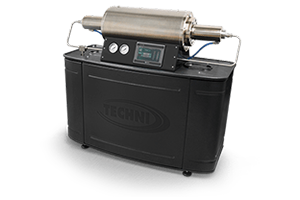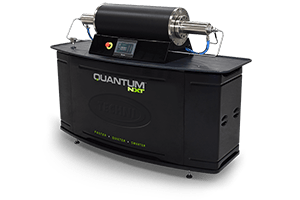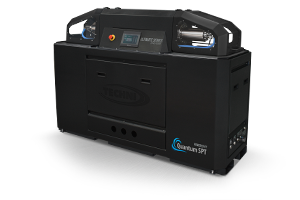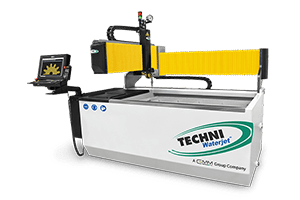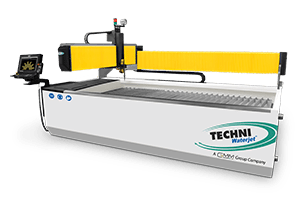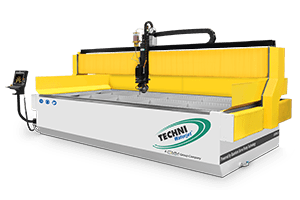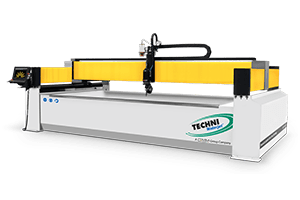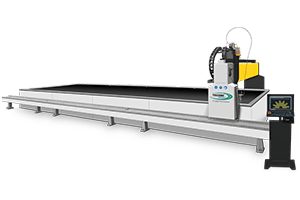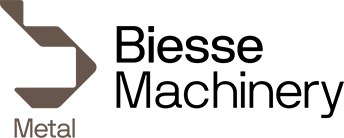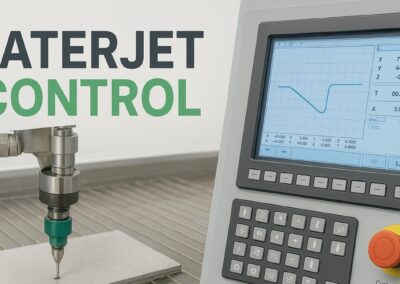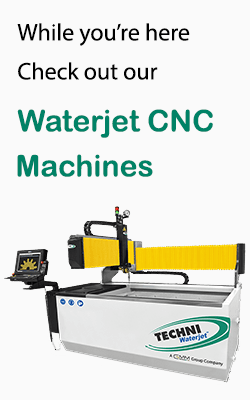The appropriate abrasive ensures that the waterjet cuts through different materials precisely, affecting not only the quality of the output but also the cost and speed of operations.
Simply choosing a cutter without considering its capabilities can lead to substandard products that fail to meet expectations, and who wants an expensive recall when it can be avoided?
This guide will help you understand the role abrasives play in enhancing the performance of waterjet cutters.
What Is the Role of Abrasives in Waterjet Cutting?
When mixed with high-pressure water, waterjet abrasives accelerate to speeds capable of slicing through hard materials like metal, stone, and glass. This process begins with the waterjet high-pressure pump, which drives water through a nozzle at three times the speed of sound.
As the water passes through the mixing tube, the abrasive particles are added to the stream, gaining velocity and mass that enable them to erode material through pure kinetic energy. The acceleration of these particles is crucial as it directly affects the efficiency and quality of the cut.
Why Is the Choice of Abrasive Crucial in Waterjet Cutting?
The choice of abrasive in waterjet cutting impacts five main aspects of the cutting process:
- Cutting Speed and Efficiency: Selecting the right abrasive optimizes the cutting speed, which can significantly enhance production throughput.
- Edge Quality and Surface Finish: The type of abrasive affects the smoothness and quality of the cut edge, which is critical for the final product’s appearance and dimensional accuracy.
- Nozzle Wear and Component Life: Abrasives with higher hardness levels can accelerate wear on waterjet components, impacting maintenance costs and operational downtime.
- Overall Operational Cost and Profitability: Efficiently balancing the cost of abrasives against their performance can lead to better cost management and profitability in operations.
- Material Compatibility: Different materials respond better to specific types of abrasives, affecting the quality of the cut and the overall efficiency of the process.
What are Key Properties of Waterjet Cutting Abrasives?
The right abrasive enhances the waterjet’s ability to effectively cut through various materials, making it imperative to choose one that aligns with specific operational requirements.
Hardness
Hardness is a defining property of an abrasive, determining its effectiveness and wear on the waterjet system.
The Mohs Hardness Scale, a standard grading for minerals based on their ability to scratch softer substances, ranks abrasives from talc, which is very soft, to diamond, the hardest known material. Here’s how common abrasives measure up on the scale:
- Talc: 1 – Extremely soft, generally not used in abrasive applications.
- Gypsum: 2 – Still very soft, with limited abrasive applications.
- Calcite: 3 – Marginally more abrasive, suitable for very soft cutting.
- Fluorite: 4 – Slightly harder, but still not ideal for most abrasive needs.
- Apatite: 5 – A midpoint in hardness, rarely used in waterjet cutting.
- Feldspar: 6 – Harder and more suitable for some types of soft material cutting.
- Quartz: 7 – A good standard for cutting a range of materials.
- Garnet: 7-8 – Highly effective for general waterjet cutting purposes.
- Topaz: 8 – Harder still, suitable for more demanding cutting applications.
- Corundum: 9 – Very hard, used for cutting very hard materials.
- Diamond: 10 – The hardest material, used for specialized cutting operations.
Density
Density affects how the mass of the abrasive particles contributes to their velocity when propelled by the water stream.
The ideal density for an abrasive maximizes the acceleration and the force of the waterjet stream, enhancing cutting power without causing undue stress on the waterjet apparatus.
Why Is Density Important for Abrasive Performance?
Density in abrasives plays a pivotal role by balancing mass and acceleration, crucial for effective cutting power.
Abrasives that are too light may lack the necessary force to cut through tougher materials efficiently, as they cannot maintain the required momentum when accelerated by the water stream.
Conversely, abrasives that are too heavy may not reach optimal velocities, reducing their cutting effectiveness and increasing wear on the machinery due to the added strain.
Toughness (Friability)
Toughness, or friability, refers to how the abrasive particles break down during the cutting process. Semi-friable abrasives like garnet are preferred in many waterjet operations due to their ability to fracture at a controlled rate.
This fracturing process continually exposes new, sharp edges which maintains the cutting efficiency without the rapid degradation of the abrasive particle size. This controlled breakdown helps in prolonging the life of the nozzle while maintaining a consistent cutting performance over time.
Particle Shape
The shape of abrasive particles plays a crucial role in determining the efficiency and the quality of the cut:
- Angular particles: These are sharp and pointed, and they cut through materials quickly due to their ability to penetrate with more precision. However, they often leave a rougher finish due to their aggressive cutting nature.
- Subangular particles: These offer a balance between speed and smoothness, making them suitable for a variety of cutting applications.
- Rounded particles: While these provide the smoothest finish, they do so at the expense of cutting speed, as their lack of sharp edges reduces their cutting efficiency.
Purity
High-purity abrasives are crucial for enhancing waterjet cutting performance. Abrasives with fewer impurities and a higher degree of purity contribute to a cleaner and more focused cutting stream, which can cut materials more precisely and efficiently.
Impurities in lower-purity abrasives, such as salts or other minerals, can lead to clogging of the nozzle and a decrease in cutting performance, as these contaminants can disrupt the flow and consistency of the waterjet stream.
Particle Size Distribution
The consistency of particle size in waterjet abrasives is vital for maintaining a smooth and stable cutting operation. Properly sized abrasives help prevent the clogging of nozzles and ensure a steady flow of particles, which is essential for the precision and efficiency of the cut.
Oversized particles can block the waterjet nozzle, causing interruptions and potential damage to the machinery, while excessively fine particles may not provide enough cutting power, leading to inefficiencies and increased wear on the system.
Cleanliness
Cleanliness in waterjet abrasives refers to the absence of dust and superfines, which are smaller than the desired cutting particle size. These superfines can accumulate and cause various issues in the cutting process, such as inconsistent abrasive flow rates and clogging of the mixing chamber or nozzle.
Maintaining the cleanliness of abrasives ensures a more reliable and consistent operation, which in turn leads to better quality cuts and less downtime for maintenance and cleaning.
Recyclability
Recycling abrasives can offer significant cost savings and environmental benefits. Certain types of abrasives, like garnet, can be recycled multiple times without losing their cutting effectiveness.
The use of recyclable abrasives not only reduces waste but also lowers the cost of materials, as recycled abrasives can be cheaper than new ones.
Additionally, using recyclable materials helps reduce the environmental impact of the cutting process by minimizing waste and the need for disposal.
Chemical Inertness
The significance of using chemically inert abrasives in waterjet cutting cannot be overstated. Abrasives that do not react chemically with the materials being cut prevent contamination of the workpiece and maintain the purity of the cut surfaces.
This inertness also simplifies the disposal of used abrasives, as there are fewer environmental regulations concerning inert materials compared to reactive ones, ensuring compliance and reducing disposal costs.
Thermal Stability
Thermal stability is a critical property for abrasives used in waterjet cutting. Abrasives that maintain their structure and composition under the thermal stresses of high-speed cutting ensure consistent performance throughout their usage.
Stable abrasives prevent premature breakdown and variability in the cutting process, which can affect the precision and quality of the cut.
Moisture Resistance
Moisture resistance in abrasives is crucial for consistent waterjet operation. Abrasives that absorb moisture can clump together, disrupting the flow through the nozzle and leading to inconsistent feed rates and clogging.
Ensuring that abrasives are moisture-resistant helps maintain a steady and reliable flow, which is essential for achieving smooth and accurate cuts.
Recyclability
Discussing the recyclability of abrasives, such as garnet, highlights both economic and environmental benefits. Garnet abrasives can be recycled multiple times without significant degradation in performance.
This not only reduces the abrasive cost per cut but also minimizes the environmental impact associated with abrasive disposal. Recycling abrasives contribute to sustainability goals by reducing waste and the need for raw materials.
What are Common Abrasives Used in Waterjet Cutting?
Understanding the different types of abrasives and their properties helps in choosing the right material for specific cutting needs.
Garnet
Garnet is a naturally occurring mineral widely regarded as the ideal abrasive for waterjet cutting due to its hardness, density, and chemical inertness.
Its characteristics allow for precision cutting at high speeds while minimizing the wear on cutting equipment.
Characteristics and Benefits:
- Optimal Hardness (Mohs 7–8): Garnet is hard enough to cut through a variety of materials, including metals, stone, and composites, without causing excessive wear to the waterjet nozzle.
- Ideal Density (Specific Gravity of 4.0): This property ensures that the garnet particles are heavy enough to be accelerated by the waterjet stream effectively, optimizing cutting power and minimizing energy loss.
- Semi-friable Toughness: This allows the particles to fracture just enough to present new cutting edges and maintain a sharp cutting front, prolonging the usability of the abrasive.
- Suitable Particle Shape: Garnet typically has subangular shapes that balance the cutting speed and the smoothness of the cut surface, providing an efficient cutting action with less material wastage.
- High Purity and Cleanliness: With low levels of inherent impurities, garnet does not contaminate materials during the cutting process, which is crucial for maintaining the integrity of the parts being cut.
Limitations:
- Cost: While garnet offers numerous advantages, it is generally more expensive than some other abrasives. However, the benefits often justify the cost in professional applications.
Applications
- Steel: Garnet’s toughness and hardness make it suitable for cutting through thick steel plates.
- Titanium and Other Metals: Its sharpness and non-reactive nature prevent altering the properties of metals, which is particularly important in aerospace and automotive industries.
- Stone and Ceramics: Garnet is effective for detailed cutting of hard materials like granite and ceramic tiles, making it a favorite in construction and decorative applications.
- Glass: The clean cuts achievable with garnet are essential for minimizing cracks and chips in glass cutting operations.
What are the Different Types of Garnet Abrasives
Before diving into the specifics, it’s helpful to understand that garnet used in waterjet cutting comes in different forms, each suited to particular types of jobs depending on the material being cut and the desired finish.
Alluvial Garnet
Alluvial garnet is known for its naturally rounded grains, a result of waterborne erosion and sedimentary deposition. This gentle shaping process in nature yields grains that are less sharp but highly consistent in shape.
Benefits:
- Smoother Edge Finishes: The rounder edges of alluvial garnet produce less jagged cuts, making it ideal for jobs requiring a high-quality finish without additional processing.
- Less Aggressive Cutting Action: This type of garnet offers a gentler approach to cutting, which helps preserve the structural integrity of the material being cut.
Limitations:
- Lower Cutting Speed: While it protects the integrity of the material, its rounded edges mean it cuts more slowly than its angular counterparts.
Applications
- Fine Finishes: If your project requires precision and a smooth surface, alluvial garnet is a suitable choice, particularly for cutting softer materials or when a polished finish is paramount.
Rock Garnet
Contrary to alluvial garnet, rock garnet is mined directly from rock deposits and mechanically crushed. This process creates sharp, angular grains that are more effective for rapid cutting.
Benefits:
- Faster Cutting Speeds: The sharp edges of rock garnet dig into hard materials more quickly, significantly reducing cutting time.
- Sharp, Angular Grains: These grains facilitate a more aggressive cutting action, which is ideal for slicing through harder or thicker materials.
Limitations:
- Rougher Edge Finish: The same sharp edges that enhance cutting speed can also leave a rougher finish, which may not be suitable for all applications.
Applications
- Thick or Hard Materials: Rock garnet is optimal for quick cutting of thick materials like stainless steel or stone, where speed is a critical factor and a smoother edge can be sacrificed for efficiency.
Mesh Grades (Particle Size) and Their Impact
Understanding mesh size is key to selecting the right abrasive for your waterjet cutting needs.
The mesh number indicates the number of holes per square inch in the screen through which the abrasive particles are sized, translating into how coarse or fine the abrasive particles are.
- 80 Mesh: This is the most commonly used mesh size, offering a good balance between cutting speed and surface finish. It’s versatile enough for both detailed work and efficient, general cutting.
- 50–60 Mesh: Coarser particles that cut faster, making them ideal for powering through thick or tough materials like steel plate or stone.
- 100–120 Mesh: Finer particles that create a smoother surface finish, suitable for detailed or decorative cutting applications on materials like glass or fine metals.
Aluminum Oxide
Known for its hardness (Mohs 9), aluminum oxide is a less common but very effective abrasive for specialized waterjet cutting tasks.
Benefits:
- Extreme Hardness: This makes aluminum oxide perfect for cutting very hard materials.
- Effective Cutting: Provides a clean and precise cut in tough materials.
Limitations:
- Rapid Nozzle Wear: Its hardness can lead to increased wear and tear on waterjet nozzles, raising maintenance costs.
Applications
- Used predominantly for cutting robust materials like ceramics and hardened steels where precision is crucial.
Silicon Carbide
With a Mohs hardness of 9.5, silicon carbide is one of the hardest abrasives used in waterjet cutting. Its sharp and hard particles make it ideal for high-speed cutting.
Benefits:
- Superior Cutting Speed: Capable of cutting through almost any material, including metals and composites, very quickly.
- Precision: Maintains integrity for precision cutting even at high speeds.
Limitations:
- Cost and Wear: High cost and potential for significant nozzle wear, which can be economically inefficient for regular use.
Applications
- Specialized industrial applications requiring aggressive material removal and where speed is more critical than cost, such as in aerospace engineering for cutting titanium or in the automotive industry for hard composites.
Staurolite
Staurolite is a mineral abrasive that offers a similar hardness to garnet, which makes it suitable for various cutting operations.
Benefits:
- Cost-Effective: It provides an economical option for general-purpose cutting, making it accessible for various industries.
- Versatility: Suitable for a wide range of applications beyond just cutting, including sandblasting and surface preparation.
Limitations:
- Material Limitations: Staurolite may not be effective on very hard materials, limiting its use in industries that process these types of materials.
Applications
- Commonly used in the cutting of softer metals and composites where precision is less of a concern but cost-efficiency is paramount.
Olivine
Known for its softer mineral form, olivine is less abrasive than options like garnet or silicon carbide.
Benefits:
- Cost-Effective: Lower cost and reduced nozzle wear translate to decreased overall operating costs.
- Environmental Impact: Often favored for its lower environmental impact compared to more abrasive materials.
Limitations:
- Speed and Efficiency: Slower cutting speeds and less effectiveness on harder materials.
- Specific Uses: Not suitable for high precision or high-stress materials, which limits its applications.
Applications
- Best used for cutting aluminum and other soft materials where the integrity of the cut surface is not critical.
Other Abrasives
While garnet, aluminum oxide, and silicon carbide are staples in the industry, several other abrasives are used for niche applications:
- Crushed Glass: Often recycled, this abrasive is softer and less damaging to the cutting equipment, ideal for light cleaning and surface prep.
- Plastic Beads: Used in applications requiring minimal surface disruption, such as in automotive and aerospace for delicate parts.
- Steel Grit: Utilized for its aggressive cutting action and commonly seen in heavy-duty industrial environments.
How to Evaluate and Select the Right Abrasive for Your Waterjet Cutting Needs?
Selecting the right abrasive for waterjet cutting involves understanding the specific needs of your cutting application.
This guide will walk you through the factors you should consider to make an informed choice.
Material Type and Thickness:
- Harder materials often require abrasives with higher hardness ratings such as garnet or aluminum oxide to achieve efficient cutting.
- Thicker materials may benefit from coarser abrasives that can cut through with less resistance.
Desired Edge Quality and Surface Finish:
- Finer abrasives, like high-grade garnet, produce smoother finishes but may cut more slowly.
- Consider the application of the cut piece—does it require a fine finish or is speed more critical?
Cutting Speed Requirements:
- Coarser abrasives can increase cutting speed, which is vital for high-volume production environments.
- However, this may compromise the smoothness of the cut edge, affecting the final product’s appearance.
Nozzle Life and Maintenance Costs:
- Softer abrasives may prolong the life of cutting nozzles and reduce downtime due to maintenance.
- Assessing the trade-off between abrasive cost and nozzle wear can help manage long-term operational costs.
Abrasive Cost and Availability:
- While some abrasives may offer lower upfront costs, their performance and the frequency of replacement could affect overall profitability.
- Availability can also be a concern; opt for abrasives that are readily available to avoid production delays.
Purity and Consistency:
- High-quality abrasives ensure consistent performance and prevent issues such as clogging and uneven wear.
- Look for abrasives with minimal impurities to maximize the efficiency of your cutting operation.
Environmental and Safety Considerations:
- Consider abrasives that are recyclable and pose fewer health risks to operators.
- Review material safety data sheets (MSDS) for handling and exposure guidelines.
Material Compatibility with Different Abrasives
Different materials react differently to various abrasives, affecting the cutting process’s efficiency and quality.
- Soft Materials (Rubber, Plastics): Often do not require abrasives; water pressure alone can suffice.
- Aluminum and Composites: Utilize garnet or olivine for a balance of efficiency and minimal damage to the material.
- Steel and Hard Metals: Prefer garnet or aluminum oxide to enhance cutting performance without excessive wear.
- Ceramics and Glass: Best served by silicon carbide or aluminum oxide for their hard, sharp qualities that cut through brittle materials effectively.
Cost Considerations
Understanding the economic impact of different abrasives can help you make a cost-effective choice without compromising quality.
- Evaluate Cost Per Pound vs. Cutting Efficiency: Some abrasives may be cheaper per pound but could result in higher overall costs due to slower cutting speeds or increased wear.
- Long-Term Costs: Consider how abrasives affect the life of the nozzle and any potential downtime for maintenance or replacement, which adds to operational costs.
- Performance Benefits: Higher-priced abrasives might offer better performance characteristics that justify the initial expense through increased productivity or lower total cost of ownership.
Comparing Cost-Effectiveness of Different Abrasives
Higher-priced abrasives like garnet might offer better value through enhanced cutting efficiency and longer nozzle life, reducing downtime and maintenance costs.
For example, using premium garnet abrasives in cutting thick stainless steel plates can achieve cleaner cuts faster, thereby reducing the cost per cut by minimizing time and abrasive consumption.
How to Achieve Optimum Abrasive Performance?
To extract maximum performance from your abrasives, setting up your waterjet machine correctly is the first important step.
This setup includes calibrating the nozzle or orifice size, which should match the type of abrasive used to maximize the cutting stream’s effectiveness.
Regular maintenance is also vital to prevent any disruptions that might arise from wear and tear on the waterjet machine, which can affect the precision and quality of cuts.
Some of the factors that can influence performance include;
- Nozzle/Orifice Size: The correct nozzle size optimizes the abrasive velocity and cutting precision. Each type of abrasive may require a different nozzle specification to achieve the best results.
- Pressure: The pressure at which the water is expelled plays a crucial role in how well the abrasive performs. Higher pressures can accelerate the abrasive to maximum velocity, enhancing the cutting ability but also increasing wear on the machine.
- Feed Rate: The speed at which the abrasive is fed through the machine must be balanced with the cutting speed to avoid inefficiencies and potential damage to the material being cut.
Which Waterjet Machines Work Best with Specific Abrasives?
Selecting the right abrasive for the type of waterjet machine you operate can greatly influence the efficiency and quality of your cutting projects.
- Standard Machines: These are typically compatible with garnet abrasives, which are known for their versatility and cost-effectiveness in cutting a wide range of materials.
- High-Precision Machines: For machines that are engineered for high precision, finer mesh sizes of abrasives can be more suitable as they provide a smoother finish and greater detail in cutting.
- Specialized Machines: For waterjets that are designed for specific types of materials or unique cutting requirements, it is best to consult with the manufacturer to find the most suitable abrasive. They can offer recommendations on whether more specialized abrasives like silicon carbide or aluminum oxide might be required to handle particularly tough or delicate materials.
Conclusion
The best choice of abrasive for waterjet cutting is one that matches your waterjet machine’s specific capabilities and design.
By taking into account factors like the type of material, the desired results, and the specifications of the machine—and consulting with manufacturers for expert guidance—operators can make informed choices that enhance performance, minimize costs, and deliver superior results.
Ongoing assessment and adjustments based on the cutting conditions and the performance of the abrasive are essential for maintaining excellence and efficiency in waterjet cutting operations.
